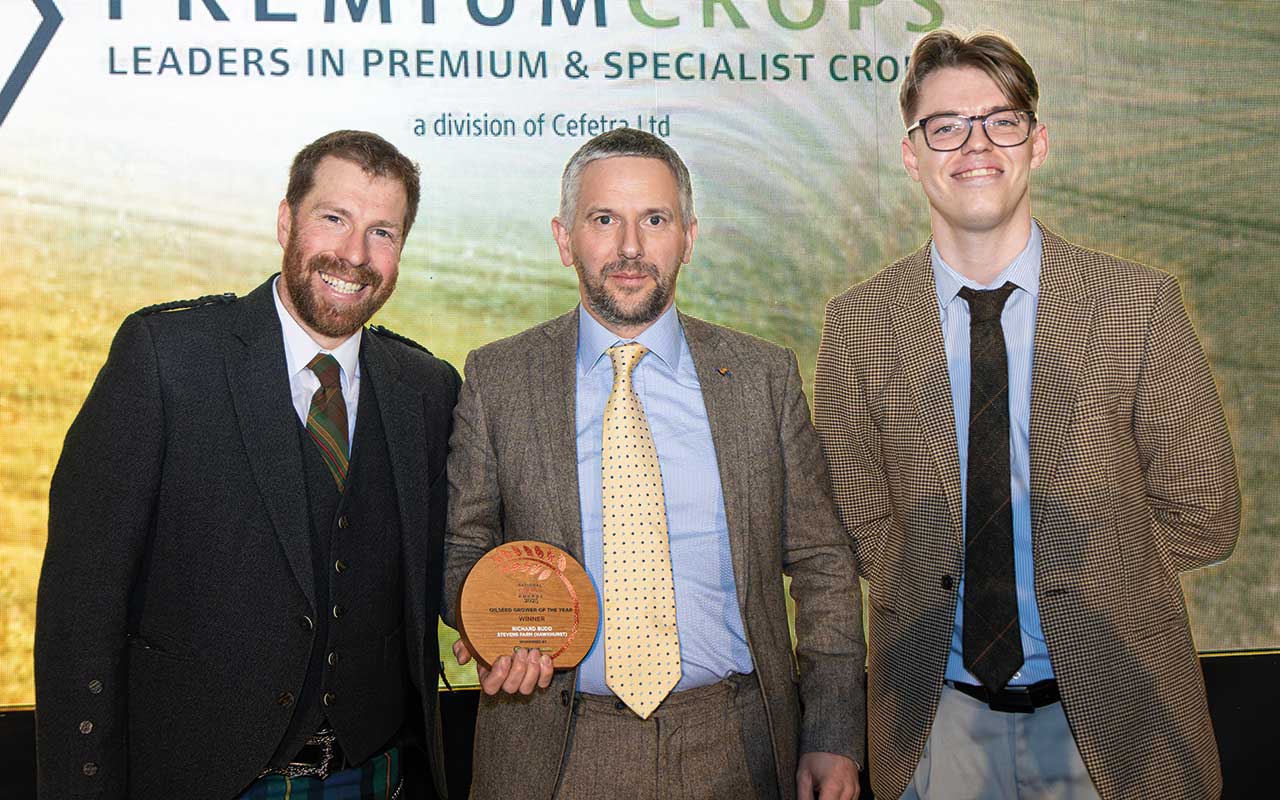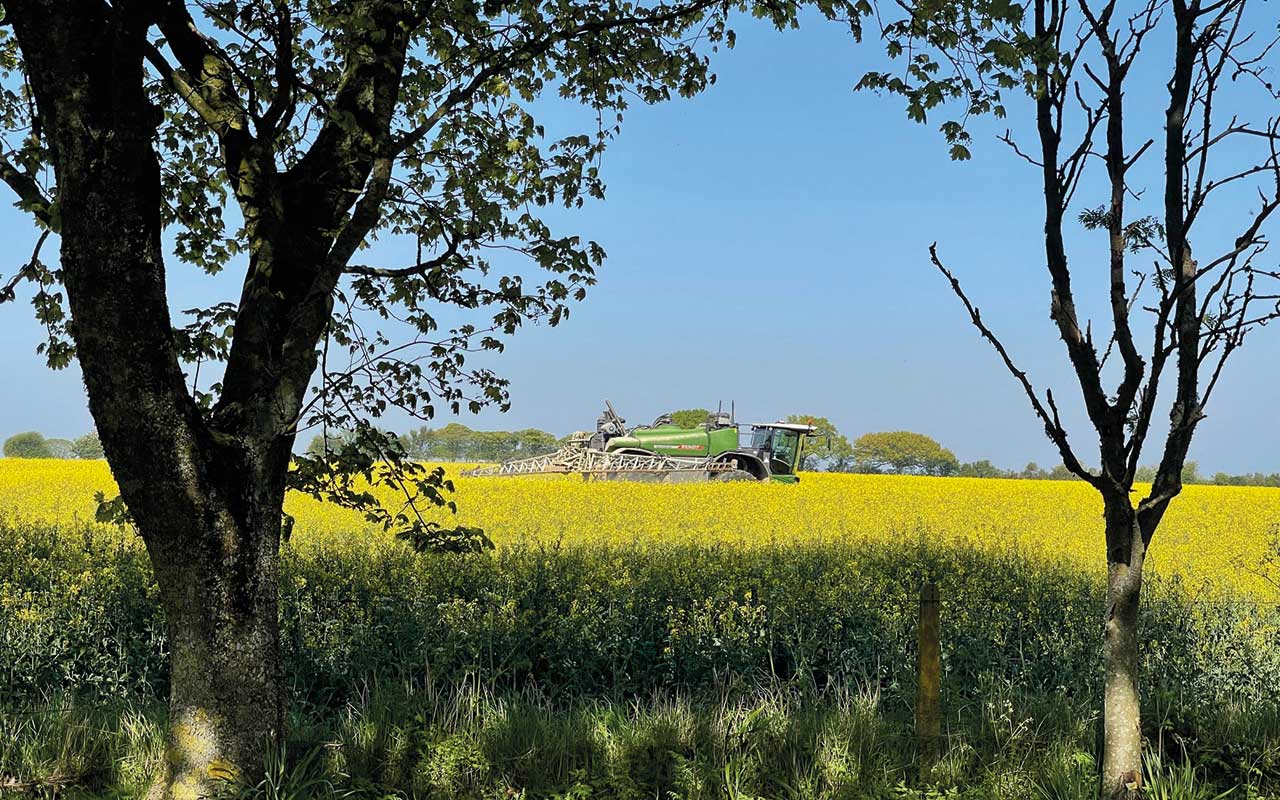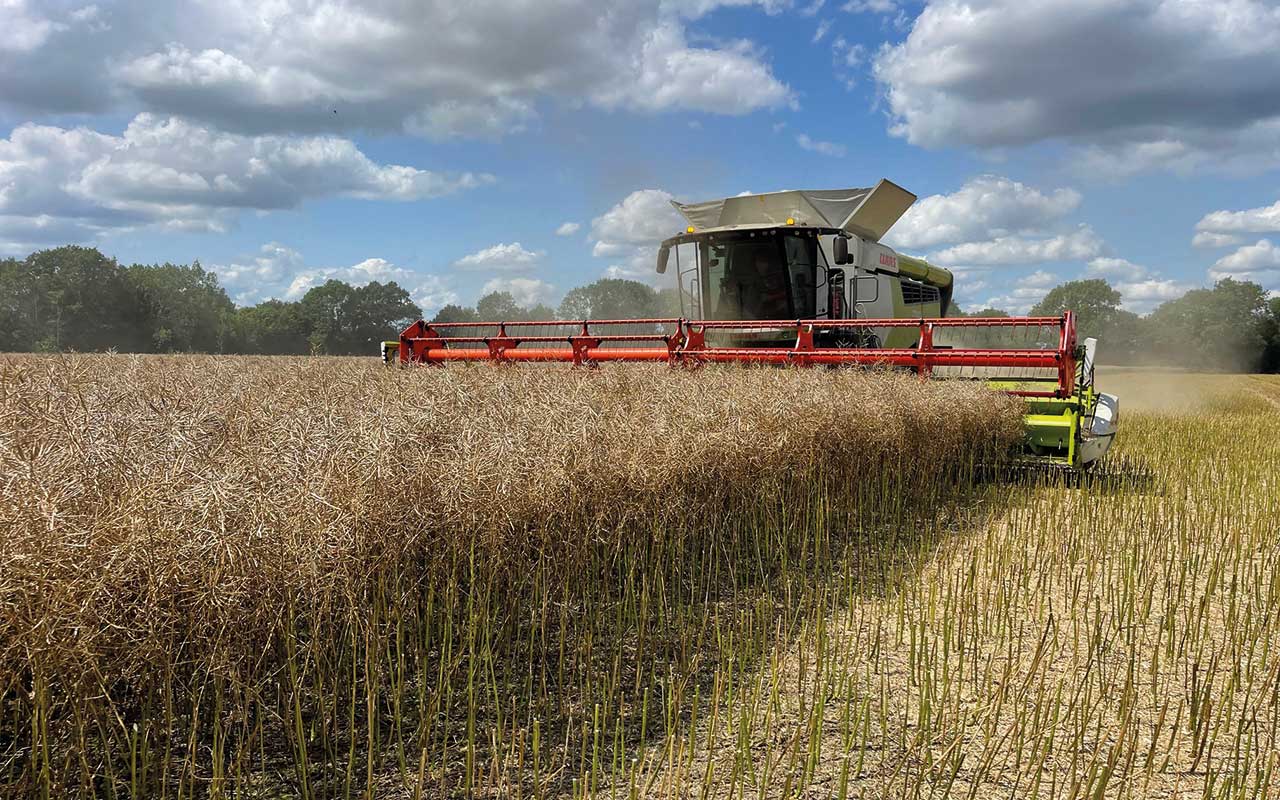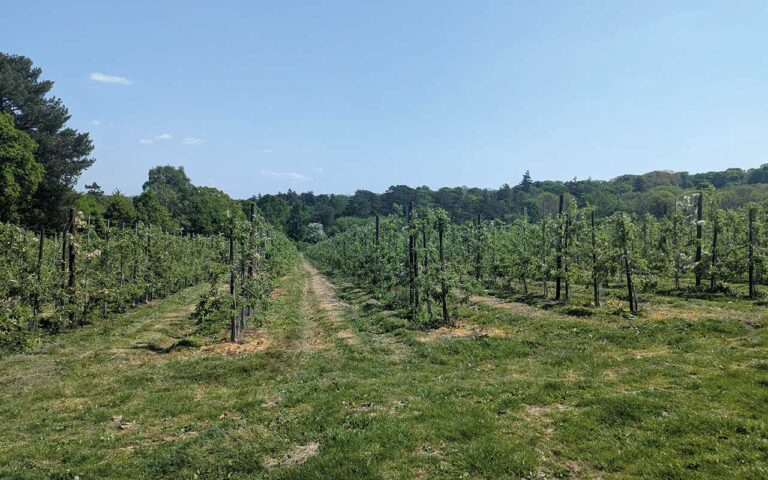Father-and-son duo David and Richard Budd operate Stevens Farm (Hawkhurst), which was established by Richard’s great-grandparents during the Second World War.
It originally began as a plot of land farmed to boost food production and has since evolved into one of the largest farms in the area, with plans for further expansion.
The farm now spans 14 sites, with 1,400ha of arable ground and 100ha of apple orchards.
Following on from his grandparents’ focus on food production, David developed the fruit business, moving from the open market to supplying major supermarkets, which is when Richard began helping him with fruit picking.
After getting a degree in botany from the University of Nottingham and a 10-year career as a wine broker, Richard returned to Stevens Farm, describing his career move as “wanting to get out of London”.

Premium Crops (right) and awards host Jim Smith © MAG/Jamie Hodgskin
Upon his return, Richard took over the arable operations. The farm was 200ha at the time, with just over half farmed in an arable rotation and the rest dedicated to apple orchards.
Richard explains that his father felt he had to “bring something to the table”, so he turned his focus to the arable rotation, which was being contract-farmed at the time.
He brought operations in-house and built a reputation locally to pick up contract farming agreements and farm business tenancies in the area.
Now exceeding 1,400ha, the arable area is overseen by Richard and two full-time employees, with seasonal help from workers on the fruit side of the business.
Stevens Farm’s arable success is built on a well-planned crop rotation and an adaptive approach to crop management.
OSR in rotation
Winter wheat is the main crop in the rotation, with some second wheats, winter barley and break crops of spring oats, winter and spring beans and oilseed rape.
The rotation is spread out across seven to eight years, with the maximum amount of time possible between breaks.
Oilseed rape remains a crucial break crop, but after repeated issues with excessive rain capping seedbeds and damaging emergence, as well as flea beetle damage, Richard decided to shift the sowing date from the traditional August bank holiday to mid-September.

“We would always sow on the August bank holiday, and the crop would nearly always be victim to heavy rainfall or attacked by flea beetle,” he explains.
“We would end up resowing large areas in the middle of September, at which point the crop would come good. After a year or two of doing this, it made sense to switch the sowing date permanently. We don’t get many frosts, so the crop continues to grow through the winter, and comes into spring with vigour.”
To build further resilience into the system, he has worked to increase organic matter in his soils, with large tonnages of sewage sludge and digestate spread across the land. This has minimised the use of synthetic nutrition while also supporting biodiversity.
He adds that he doesn’t use cover crops to boost organic matter or rooting. “I don’t like bare soil, but I try not to use cover crops, or at least not multispecies mixes,” he said.
“Because of our break crops, any brassicas or pulses in the mix could provide a green bridge for pests and diseases. Instead, we allow volunteers to germinate and then spray these off just before sowing.”
Richard takes a flexible approach to chemical use, avoiding spraying when crops are under stress due to periods of drought, such as when we visited, and relying on integrated pest management to guide decisions, including focusing on plant genetics to choose varieties that thrive in a changing climate.

Improving crop rotation
One of the first decisions Richard made on the arable side was to reduce the amount of tillage, minimising costs and avoiding new flushes of weeds.
As part of this, he looked to direct drilling where possible, purchasing a Sumo DTS tine drill due to its reliable seed placement and low disturbance.
He said he was “impressed with the Sumo’s design and quality of build, as well as the drill’s performance, and has stuck with it ever since”.
Richard occasionally pairs the drill with a low-disturbance subsoiler, either a Sumo or a Grange, depending on field conditions, to ensure good drainage.
Looking to improve the evenness of crop emergence and seeding depth, Richard later trialled the Sumo DD, a disc version of the dill. He found the Sumo DD followed ground contours more effectively, offering consistent seed placement on uneven fields, meeting seasonal demands.
Stevens Farm runs 30m tramlines with a Fendt Rogator sprayer, which has individual nozzle control and variable-rate technology. When it comes to machinery and technology, Richard believes “if the technology is available, it is important to use it”.
He says he avoids using liquid fertiliser, explaining “it adds pressure to the sprayer operator”. He adds: “Instead, we use granular fertiliser to top up the 20,000t of sewage sludge and digestate applied to the fields.”
To increase spraying efficiency, Stevens Farm has recently added a Spreadpoint mixing bowser to the operation. Richard says: “Now the sprayers are not returning back to the yard empty or to the field full.”
The bowser operator mixes the chemical and fills the sprayer directly in the field, which allows coverage of an extra couple of hundred acres a day.
Two Amazone spreaders are used to apply fertiliser, using the Argus automatic spread pattern adjustment. This helps Richard to maximise nutrients while keeping costs to a minimum. He says: “We are using less than 10t of phosphate and under 30t of potassium a year.”
The harvest is managed with the Claas Lexion and Tucano combines. Richard says: “The Tucano is ideal for smaller fields, while the Lexion is used for the larger blocks.”
Data-driven decisions
Richard’s focus on plant genetics led to him getting involved with on-farm trials. Stevens Farm was among the first 50 to be involved with BASF trials, placing early emphasis on data-led decision-making.
This led to Richard’s later involvement with the Yield Enhancement Network (YEN), which has since become crucial to how the business benchmarks and develops its arable strategy.
He explains: “YEN gives you data to make informed decisions and allows for a comparison between different subsets.”
In addition to YEN, Richard runs on-farm variety trials, consistently using the same fields each year to ensure reliable and comparable results over time.
He says this enables him to make informed variety decisions, based on data collected on his own ground. Periodically, established varieties will be swapped out for new ones that offer desirable traits.
“This is crucial to building a consistent portfolio, and I am constantly pushing to improve yields and the bottom line.”
Orchards adding value
At Stevens Farm, fruit has long been providing diversity and extra cashflow to the operation, allowing the arable business to wait for the best prices.
This flexibility enables Richard to use the 10,000t of storage available across four sites. Grain is kept on farm and sold when prices are at their best, with the proximity to London enabling them to minimise transport costs and access both domestic and international markets.
However, Richard says the economics of fruit growing has tightened. “Labour makes up about 50% of the total cost of fruit production, and in the past four years labour has increased by 50%.”
Although fruit provides useful diversity at Stevens Farm, Richard says: “It is now a less-dependable partner. With fruit you are more reliant on co-operation from supermarkets, and that is not always straightforward.”
Despite the increase in costs, Stevens Farm continues to invest in the fruit business.
A central packhouse supports the main farm. Richard says: “We pack our own fruit for the supermarkets, while also taking in fruit from smaller growers. This adds some scale, which helps.”
As the farm looks to the future, Richard believes fairer pricing from supermarkets is vital to the future of British fruit farming. “Options to automate apple growing are few and far between, which means we need action now to address the disparity between income and outgoings.”
Looking ahead
Looking to the future, Richard sees room for Stevens Farm and other established businesses to grow. This is, in part, due to the tough economics making it difficult for newcomers to enter the industry.
He plans to continue expanding the arable side of the business, insisting that he will not change the farm’s policy to pander to government schemes.
“We were part of the Sustainable Farming Incentive pilot, and there are some clear benefits, although we’re still waiting to access the full scheme. However, any environmental actions must work with the farm. We are not interested in taking land out of food production.”
He concludes that he’s lucky to have been supported by his father, who has allowed him to trial new methods and learn from his mistakes. “The industry is changing, and we need to move with it. The worst thing you can say is ‘we’ve always done it this way’.”


